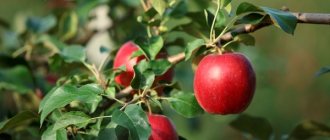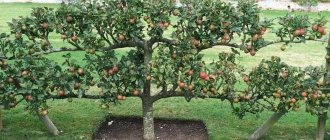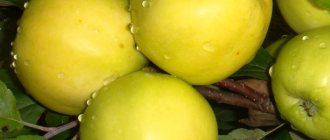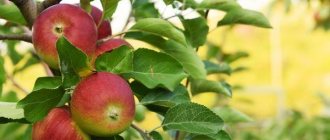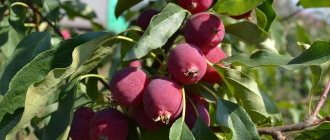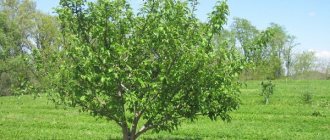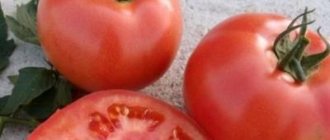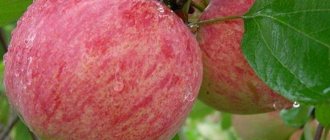Gardening » Apple tree
1
521
Article rating
Kira Stoletova
It is difficult to find a garden that does not have apple trees. These trees are often grown for their healthy fruits, beautiful appearance and other benefits. The Carpet apple tree is characterized by high productivity, excellent taste of fruits and an interesting dwarf shape.
Features of the apple tree variety Carpet
Characteristics of the variety
To obtain this species, scientists used the ancient German variety Elisa Rathke. The Carpet apple tree was bred at the South Ural Research Institute of Horticulture and Potato Growing by M. A. Mazunin, N. F. Mazunina, and V. I. Putyatin.
Advantages and disadvantages
This apple variety has many advantages:
- Its chemical composition and high consumer rating are especially valuable;
- in addition to delicious fruits, you can get an unusual garden decoration;
- apples can be easily picked from the branch without the use of additional tools.
An undoubted advantage is the small size of the apple tree, because several of these trees can be planted in one area. Thanks to their size, you can spend less money on purchasing preparations for processing.
The disadvantage of these apple trees is that with prolonged drought, the quality and taste of the fruit deteriorate. Because trees are small and wide; during snowfall, branches can bend or even break due to precipitation. To avoid this, it is necessary to constantly free the branches from snow.
Description of the tree and fruits
The Carpet apple tree is classified as a dwarf apple tree, because the height of an adult tree is 1.5-2 m.
The leaves are large, oblong, and have a very bright green color. Apples are green-yellow. Despite the small dimensions of the tree, the fruits are quite large - 170-190 g.
Taste
The taste of the fruit is standard – sweet and sour. The peel is shiny and smooth. The pulp is beige, medium-grained. The apples are slightly flattened and not too juicy.
Productivity
According to the description of the Carpet apple tree, it produces a rich harvest - up to 60 kg from one tree. Some managed to collect more than 100 kg from one mature apple tree.
Pollinators
In order for the apple tree to be pollinated, you need to have at least 2 varieties in the garden, which will be located approximately 5 m from each other. It is recommended to choose those species that bloom at the same time. The best pollinators will be the Sokolovskoye, Podsnezhnik, and Prizemlennoye apple trees.
Winter hardiness
The apple tree is resistant to cold, and drought will not do it any good, so it is important to water the tree during such periods.
Resistance to diseases and pests
Most often, fruit trees suffer from fungal diseases. This variety is not very resistant to damage by them. The Carpet apple tree can be affected by powdery mildew, scab, and tinder fungus.
The appearance of wounds on the bark of a tree signals an infection with a tinder fungus. The fruits remain intact, only the trunk is sick. It’s better if you notice something is wrong with a small lesion, then you can carefully clean everything with a garden knife and not cause harm to the tree.
If the mushroom has grown too much, then only an ax will help. Both bad and (partially) good wood will need to be cut down. It is important to remove the mushroom at the root, because otherwise it will appear again after a while. After this, the places where the tinder fungus grew should be treated with copper sulfate and covered with oil paint for quick healing.
If after heavy rain you notice a white coating on the leaves, then most likely it is powdery mildew. It affects the entire tree, starting from the bottom.
Scab appears on both leaves and fruits. First, brown-green lesions appear on the leaves, then a brown crust covers the apples themselves. The cause of the disease may be air retention in the tree crown or too high humidity.
If you regularly follow simple tips, you can protect your tree from diseases. Apple trees should be fertilized with potassium, calcium, compost, and sprinkled with ash. At the appropriate time, you need to form the crown of the tree and treat it with colloidal sulfur. Try to choose varieties that are resistant to disease and treat the apple tree at the first sign of illness.
Diseases and pests
Apple tree Persian
The apple tree is affected by carpet scab, powdery mildew and tinder fungus. When a growth of polypore fungus appears on the trunk, it is cleaned off with a knife and the area is disinfected with copper sulfate. To prevent the fungus from appearing again in the future, the affected area is painted over with oil paint.
To prevent the tree from becoming infected with powdery mildew and scab, it is recommended to double treat the tree in the spring with a solution of copper sulfate or a solution of urea. This procedure is performed in the spring until the buds swell and before the flowers appear.
The Carpet variety is an apple tree with ambiguous characteristics, because it can be grown not only to produce beautiful fruits. It can serve as an extraordinary garden decoration as an ornamental plant. The main thing is that the varietal seedling be purchased from a good nursery.
0 0 votes
Article rating
Growing regions
This apple variety adapts well to weather conditions.
According to the description of the variety, at the moment the tree has adapted best in the West Siberian and Ural regions of Russia. If you follow the rules of planting and care, the tree can adapt to many climatic conditions. Only regions that are too dry will not be suitable.
What varieties of dwarf apple trees do I grow?
In the first year, I ordered and safely received 4 dwarf apple trees - “Wonderful Brother”, “Mantet”, “Kuibyshevskaya” and “Silver Hoof”. I won’t describe how I planted the seedlings - nothing unusual, the main thing is not to bury the graft. Everything worked out fine with them - 4-5 cm above the soil level. But I got carried away with the distance between the trees, planting them 5 meters from each other. You don’t need so much, 3–3.5 m is enough.
They all took root, grow and bear fruit, and the fruits produced are exactly the ones I bought. They are very tasty, so I’ll tell you a little about each.
Dwarf apple tree (Malus pumila), variety “Wonderful Brother”. nagrunte
Variety “Wonderful Brother”
“Wonderful Brother” - an autumn apple tree with high winter hardiness - began to bear fruit in the third year after planting, and how! In the first year of fruiting, due to inexperience, we collected 14 kg of apples. But there was no need!
What did she look like, poor thing - the branches bent to the ground, she propped them up with spears, tied them to stakes, in general, it was impossible to look at the apple tree without tears. The harvest was ripe by mid-September. I placed the apples in the bottom drawer of the refrigerator, layering them with paper, as an experiment - how long can they be stored? They stayed until January. By this time they were starting to get a little flabby, but they were still tasty, good apples.
But, apparently, our apple tree overdid it and took a vacation the next year. A year later it began to bear fruit again, and this time I removed about a third of the ovaries, but, as it turned out, I needed to remove more. History repeated itself this year - again the branches broke under the weight of the fruit. Next year, I’ll probably rest again, and then I’ll leave one ovary per hand.
Variety "Mantet"
"Mantet" is a summer variety with average winter hardiness. A beautiful tree with a regular crown, now higher than 2.5 m. The first few apples appeared in the third year, a dozen in the fourth. The apples are beautiful, juicy and very tasty. The harvest increases very gradually, but in the 6th year we collected three buckets of simply excellent fruit.
Surprisingly, this year they are much larger than they were before, and I don’t know why. Maybe I liked the horse manure - I added it since the fall, or the winter was soft and snowy, but the result is amazing!
Variety "Silver Hoof"
“Silver Hoof” is simply charming. A summer variety with high winter hardiness, in which everything is beautiful - a neat, beautiful tree and plump small apples the color of ripe cherries, with thin skin and transparent pulp. It began to bear fruit in the second year, the harvest gradually increased, and this year we have already harvested three buckets of apples.
But then, on the contrary, a problem occurred - almost all of the apples were cracked. I haven’t found out the reason yet - perhaps it’s overfilling, although with our dry climate it’s simply unrealistic to overfill something. Therefore, I blame the sudden temperature change. We had very cold nights and very hot days during most of the summer.
Variety "Kuibyshevskaya"
“Kuibyshevskaya” is a winter-hardy variety that tests my patience. It began to bear fruit in the 4th year, but only this year we harvested the first harvest. Before that, she gave out 2-3 apples, which fell off long before the deadline.
In the description of the variety it was written that the apples were very large, weighing up to 300 g, but we saw them only in the 6th year, and then only after a serious conversation. Last year I talked to her, described the prospects, she apparently listened. In short, the apples are really huge, with a strong aroma and good taste for winter apples. I put it in storage, let's see how long it lasts.
So, all four of my apple trees are growing and developing according to their age. No diseases were noticed on them, they winter well. In the first years, I wrapped the trunks with spunbond for the winter, and mulched the tree trunk circle with dry grass. Now I don’t do this anymore, I just lay out rags soaked in creolin near the trunks to keep mice away.
Last year I added two more apple trees to my collection – “Persianka” and “Sokovoe-3”, and two pear trees – “Chizhovskaya” and “Sverdlovchanka”. Everything has settled down, we are waiting for the harvest.
Apple tree "Mantet". Archiland
Apple tree "Silver Hoof". Archiland
Landing
To collect tasty fruits from the Carpet apple tree, you need to carefully plant it.
The choice of seedling should be approached with special responsibility. You need to rely on the following rules:
- the seedling must be young so that it quickly adapts to the land on which it will grow;
- it must have a developed root system;
- You need to buy young trees in a region with similar weather conditions.
Deadlines
You can plant a tree at any time, but not in winter. Gardeners advise choosing the end of April, the end of September or the beginning of October for this.
Scheme
The landing site should be bright and away from groundwater. The land is needed, preferably fertile.
The pit needs to be prepared a month before planting. Because the trees grow small, the hole dimensions should be approximately 70x70x60 cm. The apple trees should be located at a distance of 3-4 m from each other. Fertilizers (superphosphates, calcium nitrate, wood ash, manure humus) are poured into the pit, which must be mixed with the ground.
A third of the hole is left to be filled with soil. It needs to be watered well with 2 buckets of water and covered with a layer of fertile soil. It is better to plant a tree together, so that one holds the seedling straight and the other buries it. After the procedure, the apple tree must be watered generously and tied to a stick so that strong winds cannot break it.
Collection and storage of fruits
The harvest is harvested at the stage of technical ripeness in early September, trying not to damage the wax coating. Fruits are sorted by size, discarding damaged and rotten ones.
For storage, apples are placed in wooden boxes or wicker baskets, lined with paper to improve shelf life. Storage is carried out in cellars and basements at a temperature of 0...+1°C with a relative air humidity of 85–95% on average until November.
Proper care and adherence to agricultural technology will allow you to collect the same harvest from a dwarf Carpet tree in a shorter lifespan as that produced by tall varieties over a longer period of fruiting.
Care
The tree must be watered all summer (every week). After this procedure or rain, the soil needs to be loosened. Twice during the summer it is worth fertilizing the apple tree with chicken droppings or mullein.
In the first year of a tree’s life, it is necessary to clean the area around it, pull out weeds and monitor watering. During this period, small pruning is also done to create a lower layer of the crown. In the second year, the ends of the branches are cut off. It is necessary to remove up to 90% of all flowers.
Shoots that begin to grow vertically must also be cut off. It is better to do this with a sharp instrument in the spring, before the buds begin to bloom. This is done so that the apples do not become smaller, and the tree bears fruit longer and does not age.
The Carpet apple tree is not afraid of cold weather, so there is no need to insulate it. If there are pests, such as hares and various rodents, you can wrap the tree with rags.
Features of "dwarfs"
All experienced gardeners know the fact that ordinary varieties of apple trees are obtained by grafting to a rootstock grown from a seed or from a cutting of a varietal crop. To grow a dwarf tree, it is necessary to graft a varietal cutting onto a special dwarf or semi-dwarf rootstock.
Attention! Currently, Russian gardeners prefer to do such grafting on apple tree rootstock b7-35 or m9.
Seedlings of dwarf varieties are sold everywhere, but they are somewhat more expensive than ordinary tall trees. In order not to purchase a “fake”, you need to know the characteristic features of dwarf apple varieties:
- there is always a clearly visible protrusion near the root collar of the “dwarf” - this is the grafting site;
- the root system of simple apple trees has a tap structure, while the roots of the dwarf variety are fibrous, small, and well branched;
- two-year-old dwarf apple tree seedlings should have large buds located at the ends of the shoots;
- the standard should have a height of no more than half a meter;
- There should be few formed branches, just a few pieces.
Important! Inexperienced gardeners may confuse seedlings of columnar apple trees with “dwarfs”. A feature of the columnar tree is a thick, even trunk and an almost complete absence of branches.
Advantages and disadvantages
Reviews from gardeners about the dwarf apple trees that exist today are contradictory: not everyone likes the features of these trees. In order not to be among those disappointed, you need to carefully study all the information about “dwarfs” and know their pros and cons.
All varieties of dwarf apple trees have several common qualities: among them there are both positive and negative characteristics. A gardener who decides to plant a dwarf tree should know about its advantages:
- Compact dimensions of the crown and root system. For normal development, a “dwarf” only needs a couple of square meters of garden. This small tree will not cast a shadow on the site or vegetable beds, and its roots will definitely not harm the foundation of the house or other outbuildings.
- The dwarf apple tree begins to bear fruit very early - already in the third year after planting, full harvests can be harvested. But ordinary varieties begin to bear fruit consistently only in the sixth or seventh year.
- The yield of “dwarfs” is comparable to the number of fruits of a standard adult apple tree. Every year the yield of dwarf apple trees increases; the tree does not slowly age.
- Caring for a dwarf apple tree, harvesting from it, pruning and spraying is much easier, because the branches of the tree are at human eye level. The gardener will not need ladders, stepladders or other special equipment.
- The crown of the “dwarf” is small, so the branches and leaves need very little nutrition. All nutrients and moisture from the soil go directly to the fruit, which significantly affects the taste and size of the apples.
- The trunk of the dwarf apple tree is short, all substances move quickly along it, and the roots located close to the surface immediately absorb water and fertilizers from the soil. This structure allows the fetus to quickly and fully receive the necessary nutrition.
- Significantly less fertilizers and means for treating the crown will be needed than in the case of tall apple trees.
- The bark of “dwarfs” is thinner; the tree stops growth and development earlier with the onset of cold weather. Therefore, compact apple trees have time to prepare for wintering, as a result of which they rarely freeze out. Winter-hardy dwarfs are increasingly becoming the choice of gardeners from the Urals and Siberia.
Advice! The branched surface roots of the “dwarfs” allow them to be planted where ordinary trees would probably die: unfavorable soils, nearby groundwater. Thanks to this quality, it is possible to plant an orchard where nothing has grown before.
Unfortunately, dwarf varieties also have disadvantages:
- Short lifespan. Unlike ordinary varieties, which can bear fruit for up to forty years, “dwarfs” live only 15-20. But in this period you can collect as many apples as an adult tree would produce in half a century. In addition, the gardener will be able to change the varieties of apples on his plot more often.
- In conditions of little snow but frosty winter, roots located close to the surface may freeze. To prevent this from happening, the soil around the “dwarf” trunk is insulated, mulched or covered with agrofibre.
- Since short roots will not be able to get food from the depths of the earth, the dwarf apple tree will have to be watered more often and better fertilized.
- A lot of ovaries are formed on the “dwarfs”; a fragile tree cannot always grow such a quantity of full-fledged and tasty fruits. Therefore, it is recommended to thin out the inflorescences, cutting off some of them in the spring.
- Under the weight of large apples, a dwarf tree can easily break, so supports, trellises, and arches are needed.
There is nothing ideal in the world; the owner of a dwarf garden must learn to neutralize all unfavorable factors. Dwarf apple trees are indeed capable of producing more abundant harvests; the fruits on these trees can be very large and not inferior in taste to ordinary ones, but for this the gardener must work hard.
Subspecies and options
If you really like this variety of apples, but there is no way to plant it, you can use a cutting. To do this, you need to choose a tree in the garden that is resistant to cold and pests, and graft the Carpet apple tree rootstock or part of it with a bud onto it.
The dwarf apple tree is an autumn variety that begins to bear fruit in the 4th year after grafting. Characterized by high productivity. Trees have larger buds at the ends of branches. Dwarf apple trees are more expensive than regular ones.
You can distinguish an apple tree on a dwarf rootstock from a semi-dwarf variety only by the size of the mature tree. Semi-dwarf trees are a quarter smaller than usual, and dwarf trees are 2 times smaller.
Fruiting, flowering, fruit ripening
The fruiting period starts after 2-3 years from the moment of planting.
When the plant reaches 5 years, it produces a full harvest. All parts of the apple tree bear fruit - both young and adults.
Flowering begins earlier on lower branches.
Long flowering guarantees a harvest even if there were frosts. The variety belongs to the autumn variety, adjusted for the fact that autumn is Siberian or Ural.
Reviews from gardeners
According to gardeners, Carpet apples are excellent apples. The fruits are collected in the fall and most often processed: they are used to make jam, jam or compote. Apples are sour. The tree is not picky about care. Already 3 years after planting, you can reap a rich harvest.
Apples are stored well in boxes, so you can eat them fresh for a long time. Gardeners are also pleased that the tree is winter-hardy. Some owners of Kovrovoe apple trees say that they do not receive a harvest after 3 years, but do not lose hope of still enjoying the taste of these fruits.
Maturing and fruiting of Carpet
Beginning of fruiting
The trees are quite early in life; they begin to bear fruit no longer than 3-4 years after planting in open ground. Moreover, the flowers may bloom earlier, but it is better to pick them off immediately, most likely they are barren flowers, they will only waste the energy of the apple tree. You shouldn’t expect much from the first harvests, because you won’t be able to collect more than 1-3 kilograms of tasty large fruits.
Flowering time
Buds on the tree appear in April, almost along with young, tender light green leaves. They begin to bloom in mid-May, not all together, but starting from the lower branches. The tree seems to “light up” from the bottom up, like a Christmas tree. This gradual flowering makes the flowering period more extended, allowing more pollinators to be reached. The flowers themselves are large, pink, strongly fragrant, saucer-shaped, and cover the branches with a dense covering.
Fruiting and growth
Kovrovoe grows relatively quickly, stretching by 45-50 centimeters per year, and sometimes even more. It very quickly reaches its maximum height, beginning to produce good yields already 7-8 years after planting in the soil. By that time, the maximum indicators will not yet be achieved, but the variety will definitely be able to provide 1 person with pleasant preservation for the winter.
Fruits begin to ripen as early as September, sometimes in October. More exact dates depend on the region, climate and weather in a particular year. They stay tightly on the branches for 2-4 weeks even after they are fully ripe, so there will be time to collect them. They can be transported well, but they can be stored for no more than 45-60 days. After this, the consistency becomes loose, cottony, and very little juicy, and the taste is sour, bitter, and unpleasant.
Why do apples fall
- Weather conditions.
- Early frosts.
- Pests or diseases.
- Overripe.
What to do if it doesn’t bloom or bear fruit
- Protect from drafts.
- Limit or activate watering.
- Eliminate pests.
- Stop diseases.
Top dressing
- Manure.
- Compost.
- Humus.
- Superphosphate.
- Chicken droppings.
- Mineral and nitrogen complexes.
- Ammonium nitrate.
Leave a review from your own experience about the Carpet apple tree variety, so that even novice gardeners will not have any questions about cultivating trees.
Previous
Apple tree varieties
